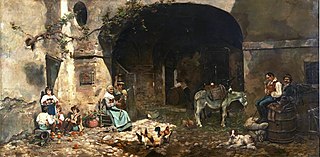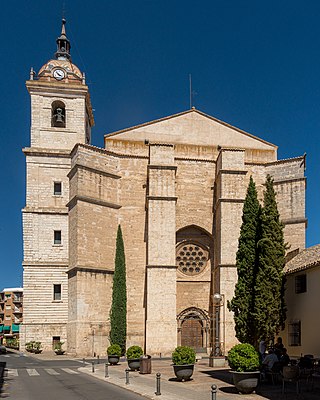
Castilla–La Mancha is an autonomous community of Spain. Comprising the provinces of Albacete, Ciudad Real, Cuenca, Guadalajara and Toledo, it was created in 1982. The government headquarters are in Toledo, and its largest city is Albacete.

Ciudad Real is a municipality of Spain located in the autonomous community of Castile–La Mancha, capital of the province of Ciudad Real. It is the 5th most populated municipality in the region.

Cuenca is a city and municipality of Spain located in the autonomous community of Castilla–La Mancha. It is the capital of the province of Cuenca.

Alcázar de San Juan is a city and municipality of Spain located in the province of Ciudad Real, autonomous community of Castilla–La Mancha. It lies on the plain of La Mancha. From the 13th to the 19th century the history of Alcázar is strongly linked to the Grand Priory of the Order of St. John of Jerusalem. The city became a railway hub in the 19th century.

A parador, in Spain and other Spanish-speaking countries was an establishment where travelers could seek lodging, and usually, food and drink, similar to an inn. In Spain since 1928, a Parador is a state-owned luxury hotel, usually located in a converted historic building such as a monastery or castle, or in a modern building in a nature area with a special appeal or with a panoramic view of a historic and monumental city.

Chinchón is a town and municipality in the Community of Madrid, Spain. Located 50 km south-east of the city of Madrid, the municipality covers an area of 115.91 km2. As of 2018, it has a population of 5,239. Its historic centre, with a notable main square, was declared a Heritage Site in 1974.

The Cabildo of Buenos Aires is the public building in Buenos Aires that was used as a seat of the town council during the colonial era and the government house of the Viceroyalty of the Río de la Plata. Today the building is used as a museum.

Almagro is a town and municipality situated in Ciudad Real province, in the autonomous community of Castile-La Mancha, Spain. A tourist destination, Almagro is designated a Conjunto histórico, a type of conservation area.

Hacienda Juanita is a coffee plantation hacienda in the town of Maricao, Puerto Rico. The design is based on typical Puerto Rican culture, and was commissioned by the wife of a Spanish official. Coffee production at the hacienda declined from the 1960s.

The Puerto Rico Tourism Company is the government-owned corporation in charge of tourism matters and regulations in Puerto Rico. The company was created during Governor Luis A. Ferré's administration (1969-1973) to coordinate the marketing and growth of Puerto Rico's tourism sector. It is governed by a board of directors and an executive director appointed by the Governor of Puerto Rico with the advice and consent of the Senate of Puerto Rico.

Corral de comedias is a type of open-air theatre specific to Spain. In Spanish all secular plays were called comedias, which embraced three genres: tragedy, drama, and comedy itself. During the Spanish Golden Age, corrals became popular sites for theatrical presentations in the early 16th century when the theatre took on a special importance in the country. The performance was held in the afternoon and lasted two to three hours, there being no intermission, and few breaks. The entertainment was continuous, including complete shows with parts sung and danced. All spectators were placed according to their sex and social status.

The Holy Priory Church Cathedral Basilica of the Military Order of Our Lady Saint Mary of the Prado of Ciudad Real is located in Ciudad Real, Autonomous region of Castile-La Mancha, Spain. Construction began in the 15th century in Gothic style, although it has elements of late Romanesque, Renaissance and Baroque styles; it has undergone many restorations with the first remodelling credited to Alfonso X since the Romanesque period. It was completed in the mid 16th century after construction of the roof vaults. The tower was built in the early 19th century. The structure is a monument indexed in the Spanish heritage register of Bien de Interés Cultural under the reference RI-51-0000514.

The Covento de San Gil currently houses the Cortes of Castilla-La Mancha. It was a convent and currently a government building located in the city of Toledo dating to the 17th century. The Dicalced Franciscans, or gilitos, arrived in this city in the middle of the 16th century, and established it in 1557 in the vicinity of the Ermita de la Virgen de la Rosa. Later, in the early-17th century, two brothers, Francisco and Juan de Herrera, donated to the friars 16,000 ducats for the construction of the new convent.

The Convento de la Madre de Dios is a Dominican convent located in the city of Toledo. It was founded at the end of the 15th century as a nunnery by Leonor and María de Silva, daughters of the Count of Cifuentes. It was a cloistered monastery, a Guardia Civil barracks, and finally a university campus after its acquisition by the University of Castilla-La Mancha to expand the facilities of the Faculty of Juridical and Social Sciences.

The Convento de la Purísima Concepción, also called Convento de Capuchinas, is a convent located in the city of Toledo, in Castile-La Mancha, Spain.

The Palace of the Counts of Maceda, or Casa del Barón in Pontevedra, Spain, is an original Renaissance pazo dating from the 16th century. It is currently a four-star hotel belonging to the Paradores network.

The Convent of St. Francis is a Franciscan convent located in the city centre of Pontevedra (Spain), overlooking the Plaza de la Herrería. The Gothic church of San Francis is attached to the convent on the southeast side.

Paradores de Turismo de España S.M.E.S.A., branded as Paradores, is a Spanish state-owned chain of luxury hotels that are usually located in historic buildings or in nature areas with a special appeal. Its very first parador was inaugurated on 9 October 1928 in Navarredonda de Gredos (Ávila). As of 2022, it operates 97 paradores in Spain and one in Portugal, with 5,988 rooms in total. Every parador has its own restaurant offering the regional gastronomy of its area.
José Luis Picardo Castellón was a Spanish architect, muralist, draughtsman and illustrator, usually known professionally without his matronymic as José Luis Picardo. As an architect he worked in contrasting architectural languages throughout his career, from the acclaimed modernist headquarters of the Fundación Juan March in Madrid to the neo-Renaissance style School of Equestrian Art in Jerez de la Frontera, by way of the many medieval-inspired hotel projects he carried out for the Paradores de Turismo de España. While still a student of architecture he made a name for himself as a muralist, embellishing many significant modern interiors in Spain. His drawing skills and his abilities in perspective brought him to the attention of a number of leading architects after the Spanish Civil War, and for some years he provided illustrations, cartoons and covers for two of the foremost Spanish architectural magazines. He also designed interiors, furniture and light fittings for many of his architectural projects. In later life he was elected an Academician of the Real Academia de Bellas Artes de San Fernando and was awarded the Antonio Camuñas Prize for Architecture.

The Castle of Monterrey is a 15th-century castle at Monterrey, in Orense, Galicia. It is located at what was then a strategic point on the frontier between the kingdoms of Galicia and Portugal.























